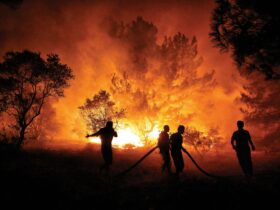Earthquakes are a reality of Türkiye, the world and nature, and unfortunately we, the Turkish people have to face this reality very often. While the devastating and painful consequences of the February 6 earthquakes centered in Kahramanmaraş are still very fresh, while it is still unknown whether the debris removal works and if it will make us prepared for a new earthquake, we are rapidly moving towards the great Istanbul earthquake in a strange expectation, we are approaching a new reality. Earthquakes are now our daily reality and they are constantly shaking us with their precursors and aftershocks. And like every dramatic reality full of pain, they are closely reflected in various branches of art.
“Disaster films” constitute a special genre in the history of seventh art: cinema. And the most shocking ones are those that depict earthquakes. Volcanic eruptions and floods aside, earthquakes have a special place in the eyes of filmmakers. Dozens of films have been made based on earthquake disasters, most of which have actually happened; the waves coming from the bottom have shaken the screen, and the terrible roar coming from the underground has never left the ears of moviegoers. Interestingly, some films have also treated the earthquake as a “solution-bringing” event. When we take a look at the movies about earthquakes, we come across dozens of examples spanning a very wide area.
First up is a documentary film. On January 14, 1931, as the plane in which the famous Soviet director and film theorist Sergey M. Eisenstein and his team were on their way to the region where the film “Long Live Mexico” was to be shot, passing over Oaxaca, an earthquake started below and the great destruction was recorded on camera by Eisenstein’s close colleague Tisse. Thus, Eisenstein, who made the cinema of the revolution that shook the world, also witnessed this tremor.
One disaster after another
Directed by W. S. Van Dyke, 1936’s “San Francisco” is one of the first disaster films in the history of cinema and presents one of the best-known earthquake stories. The movie focuses on the love and career problems of a music hall manager, but the earthquake of 1906 overtakes everything with its devastation. “San Francisco”, which conveys the moment of the earthquake in a very impressive way with the cinema technology of about 87 years ago, is also remembered for its scenes of rescuing the wounded from under the rubble.
“The Rains Came” (1939) is a melodrama set in a poor Indian setting. Director Clarence Brown also sequences disasters one after the other. First there is an earthquake, then floods and epidemics.
Federico Fellini’s “Satyricon” (1969), in which he portrays Rome as a long orgy of eating, drinking, cruelty and sexuality, with strange characters and situations, paints a picture of a society in which the Romans have nothing to do with traditional moral values. Two young students, Ascilto and Encolpio, are in love with a boy named Gitone and Ascilto “steals” the boy from his friend, but Encolpio, who is not idle, manages to get Gitone back. Together they take refuge in a palace full of sin and sinners. Ascilto follows them to the same place. Betrayed by his young lover, Encolpio tries suicide, but a sudden earthquake destroys the palace… For the poor lover who survives the earthquake, days of cruelty lie ahead.
Artificial earthquakes
Superman, the famous comic book hero on a mission to protect the world against evil and villainy, turns his full power against the evil Lex Luthor in Richard Donner’s 1978 film “Superman”. Luthor wants to add value to his territory by destroying the coast of Western California with an artificial earthquake, and the scientists in his gang are working to increase the intensity of the quake.
Coming from Soviet cinema, “Karakum Desert, 45 Degrees In The Shade” (1982) by Choudzakuli Narliev finds a place in the relationship between cinema and earthquake by telling the story of an artificial earthquake for the benefit of humanity. The artificial earthquake phenomenon, which today is used in some entertainment centers such as Disneyland with the logic of “rock and roll” to increase adrenaline, undoubtedly serves very different purposes in Narliev’s film.
In the film, Gozel Devletova, a manager at a production center, is dealing with an accident caused by a gas leak. The story told by her father, a shepherd, inspires the idea of creating an artificial earthquake to stop the gas leak, which could cause great environmental and economic damage.
While “Deep Core” (Rodney McDonald, 2000) presents a story of earthquakes that occur when a giant oil company, while experimenting with drilling with a vehicle it has developed, triggers a fault line in the Pacific Ocean, upsetting the tectonic balance, “Power Play” (2002), directed by Joseph Zito, follows in a similar vein. Southern California is shaken by a series of earthquakes. The US is facing a major energy crisis.
Los Angeles is crumbling
Los Angeles is the city most often associated with earthquakes in the history of cinema. The famous Mark Robson movie “Earthquake” (1974) depicts unforgettable scenes of Los Angeles being hit and destroyed by an earthquake. The message of the movie, which includes long and impressive earthquake scenes, is that “earthquakes love and need negligent managers who ignore warnings”.
In “The Guardian” (1990), William Friedkin also engaged with eerie mystical forces and did not neglect to include the fear of earthquakes among them. Friedkin, exposing the primitive and mystical fears that have infiltrated the psyche of a very modern, civilized-looking American society, also reveals another side of fear with the earthquake phenomenon that continues to threaten throughout the film.
In the Lawrence Kasdan film “Grand Canyon” (1991), which debates whether Los Angeles is heaven or hell, we get to know the lawyer and his wife, who are going through a mid-life crisis and longing for children, through the disasters that happen to them. The lawyer, who falls into the hands of a gang of troublemakers on the night his car breaks down and narrowly escapes death, suffers the wrath of nature along with his wife, and as if the problems in his personal life were not enough, he is also shaken by an earthquake.
Robert Altman’s astonishing film “Short Cuts” (1993) also shook the screen. Based on Raymond Carver’s story, Altman poses the question of Los Angeles: “Does everything that makes up this city have a logic, an order?” and with the earthquake at the end, he answers: “Can an earthquake change this empty and meaningless life?”
While James Yukich’s “Double Dragon” (1994) depicts the events that unfold when the people of Los Angeles, living in fear, despair and helplessness after the terrible earthquake, fall into the hands of a gang so ruthless that they forget the pain of the earthquake, John Carpenter’s “Escape From L.A.” (1996) is a very interesting example of right-anarchist action by trampling on the values that shape American society such as basketball, media and sexuality. A massive earthquake in Los Angeles has left the city in ruins and turned it into an island of hell surrounded by water.
A cruel South American “revolutionary” takes over the island. In Richard Friedman’s 2000 film “Ground Zero”, Kimberly, after losing her father in the earthquake, starts working as a seismologist and, together with her son, tries to study earthquakes in the jungles of Los Angeles to prevent further disasters.
The last example we can give about Los Angeles is the 2015 Brad Peyton film “San Andreas Fault”… A magnitude 9 earthquake strikes the city and a firefighter, who is going through a divorce with his wife, takes action to save his daughter under the rubble.
Earthquake miracle
“Miracle on I-880”, directed by Robert Iscove, approaches the reality of earthquakes. A severe earthquake in San Francisco has caused major damage to the I-880 highway and many people are trapped under piles of concrete. The rescue team led by Dr. Jim Betts mobilizes and tries to help a group of people who are resisting death. Iscove shows that miracles in debris removal and rescue are as inevitable as earthquakes are inevitable.
In “A Kid King Arthur’s Court” (1995), 14-year-old Calvin is an introverted, shy boy, but one day on the soccer field, a miracle happens. An earthquake strikes, the earth ruptures, and our young hero, who falls through the rift, travels back in time to the Middle Ages, to the court of the legendary king Camelot. He is now the knight who will help Arthur in his difficult situation against the wizard Merlin.
Can earthquakes be foretold, can their arrival be understood? Scientists are working hard in this direction, so are fortune tellers, psychics and charlatans… George Mailey, who lives in the small town of Harmon, is neither a scientist nor a charlatan; he is an auto mechanic. The fact that he predicts the earthquake well in advance does not earn him respect or money, but only “uncanny”! John Turteltaub’s “Phenomenon” (1996) approaches the earthquake phenomenon from the dimension of “forewarning”.
The earth is shaking… also on the silver screen!
One of the most interesting examples of filmmakers’ approach to the earthquake disaster comes from Iran… In Abbas Kiarostami’s 1991 film “Zendegi Va Digar Hich”, a director travels with his son to a city that has recently suffered a major earthquake disaster, in search of a young actor who appeared in one of his films. In fact, this child is the actor Kiarostami worked with in “Khaneye Doust Kodjast?”. As the film follows this search in the aftermath of the earthquake, we witness how a real disaster can be interpreted in many different ways. Kiaroatami created an “earthquake trilogy” after the earthquake in Iran in 1990, and “Zire Darakhatan Zeyton” (1994) is the last part of this trilogy.
An earthquake shakes, shakes, destroys and nothing is the same after the destruction. Directed by Fred Olen Ray, 1995’s “Cyberzone” takes the audience 50 years after the 8.7 magnitude earthquake in the USA. A new city called New Angles has been established kilometers under the sea. The earthquake, which has defeated American civilization, has given birth to a new one.
“Giro Di Lune Tra Terra E Mare”, made by Italian director Giuseppe M. Gaudino in 1997, tells the story of the gulf city of Pouzzuoli between 538 BC and 1984. In the early 1970s, the land along the gulf was affected by the rise and fall of the waters, and the connection between man and the land was at a breaking point. Gaudino tells the story of the Gioia family, fishermen, who are forced to leave their earthquake-damaged home. Through the story of the earthquake and the family’s struggle to rebuild their lives, the film says that “not much has changed” over the centuries.
Aftershocks
Next up is the action-drama “Earthquake In New York” (1998). Director Terry Ingram tells the story of detective John Rykker, who loses his young son in the great California earthquake and moves to New York with his wife Laura and their two other children. Four years have passed. Just when the family is starting to recover, the disaster that destroyed their lives is repeated in New York.
Let’s also talk about the television mini-series. In the 1999 movie “Earthquake in New York” directed by Mikael Salomon, the shock of the earthquake that devastated New York City is still being felt and violent aftershocks continue. Tom Skerritt plays a hero who keeps his cool but is limited in what he can do in a city in panic and anticipation of a new earthquake.
“Corelli’s Mandolin-Captain Corelli’s Mandolin” (2001), based on the book of the same name by Louis de Bernieres and directed by John Madden with a cast including Nicholas Cage, Penelope Cruz, Irene Papas and John Hurt, also makes the audience experience a violent earthquake. The movie takes place during the Second World War and tells the story of Italian soldiers sent to the Greek island of Cephalonia.
In “Corelli’s Mandolin”, the earthquake that devastated the island and destroyed the house where Pelegia, the music-mad Captain Antonio Corelli was in love with, lived with her father, is portrayed in all its reality.
Destruction and aftermath in China
The terrible earthquake that hit the northeastern Chinese city of Tangshan on July 28, 1976, claiming the lives of 242,000 people, was also captured on the big screen in “tang shan da di zhen-aftershock” (2010). Directed by Feng Xiaogang, the movie reflects the 7.8 magnitude earthquake, which lasted 23 seconds, in all its truth. With 180,000 buildings destroyed and one out of every four people in the city killed, the earthquake is one of the biggest disasters in modern Chinese history, and “traces of the disaster” tells a story that covers a wide period of time, starting with the scenes of the earthquake in 1976 until the Sichuan earthquake in 2008.
Turkish cinema also shook a lot
The fault line also passes through Türkiye and Turkish Cinema.. While Renan Fosforoğlu’s directorial debut “Köprüaltı Çocukları” (Underground Children) (1953) presents the story of a family of three who leave their hometown due to the earthquake disaster and come to Istanbul, only to be swindled and suffer a second disaster, Remzi Cöntürk’s 1966 film “Yaşamak Haram Oldu” (Living became a sin) depicts the earthquake disaster in Varto in the same year.
Lütfi Akad’s “Gökçe Çiçek” (1973) also takes its place in our cinematic history with a technically successful earthquake scene. In the 19th century film, which tells the story of how the Ottoman hereditary lands began to fall into the hands of beys, Selman Ali and Ahmet, both in love with Gökçe Çiçek, are passing through a pass with their animals when the ground shakes. There is an earthquake, all the rocks fall on the people in the pass, all the animals perish and one person dies. Gökçe Çiçek, a semi-saintly figure, “heard the earthquake inside” and shouts out and informs the whole obaya…
There is no doubt that Şerif Gören’s film is the best known and most memorable earthquake-related film in Turkish cinema. “Deprem” (1976), a melodrama with an unusual structure, uses this natural phenomenon on the big screen by underlining its “solution-bringing” characteristic. Zeynep, a beautiful peasant girl who has not yet married despite her advanced age, marries a man she does not really love because of her pride and falls into unhappiness. However, her heart is with a young man with a flirtatious spirit… While all kinds of troubles and pains caused by delayed love prevail, a sudden earthquake at the end of the movie will be the definitive solution to everything. The great tremor during Zeynep’s birth in the middle of nature catches the audience unprepared as the story unfolds. “Earthquake” has already taken its place in our cinematic history as the most famous example on the subject, albeit with earthquake footage “borrowed” from a foreign production.
Like an earthquake…
Reşat Nuri Güntekin’s novel “Değirmen”, Turgut Özakman’s play “Sarıpınar 1914” based on the novel, and Atıf Yılmaz’s film “Değirmen” (1986), which is entirely based on Güntekin’s novel… The movie, which tells what happens to the people of Sarıpınar who live in their own world during World War I, can easily be called “the most interesting earthquake story in world cinema”. The only entertainments for the men of the town are the parties where the beautiful Bulgarian girl Nadya enchants the participants. One day, in the house shaking with Nadya’s belly dancing, panic breaks out because “there is an earthquake”; many people are injured, including the district governor, who runs away and jumps out of the windows. News of the earthquake spreads quickly, reaching Istanbul and reaching the ears of the sultan. Aid started to arrive to heal the wounds of the earthquake. The townspeople then start to behave as if they had really suffered an earthquake disaster.
On our list is “O Şimdi Asker” (He is a soldier now)(2003), which tells the story of 28-day soldiers from all over the world and Türkiye who use their right to do paid military service, which was enacted by a special law to raise money for earthquake victims after the great disaster of August 17, 1999. Nihat, one of the soldiers, a fisherman, sees the destruction and loses his family and everything in the earthquake that strikes one night while he is out to sea. The movie depicts a second earthquake, this time in a very fantastical way. At a time when our heroes begin to feel “like real soldiers”, the earthquake creates a tiny island in the middle of the Aegean Sea and a territorial dispute erupts between Türkiye and Greece.
Earthquake trauma
Muammer Özer includes a humorous earthquake scene in “Hollywood Kaçakları” (1997); just as the boy nicknamed “Miki” is about to be circumcised, an earthquake strikes, everyone runs away and the boy is left alone.
Reha Erdem made the audience experience a 5.9 magnitude earthquake towards the end of his 2004 film “Korkuyorum Anne” (I’m scared mom), and in his 2013 film “Şarkı Söyleyen Kadınlar” (Singing Women), he set Büyükada as a place where most of the inhabitants are abandoned due to an earthquake warning, and focuses on the lives of a handful of people left behind.
The Durul Taylan-Yağmur Taylan film “Küçük Kıyamet” (Small Apocalypse) (2006), whose screenplay was written by Doğu Yücel, takes the trauma of “disaster expectation” as a starting point for the possible Istanbul earthquake and focuses on the unbearable psychological conditions Bilge, who lost her mother in the earthquake, finds herself in. Alpgiray Uğurlu’s 2016 film “Enkaz” is another film that reflects the earthquake disaster in all its reality. In the movie, which features only two characters, a young girl named Nisa (Akasya Asıltürkmen) is trapped under concrete blocks after a massive earthquake and can barely breathe. Her cell phone is dead and she tries her best to make her voice heard by the rescue teams in her agony.
It is clear that new earthquakes will occur and their repercussions will continue in the art of movie making.

















Leave a Reply